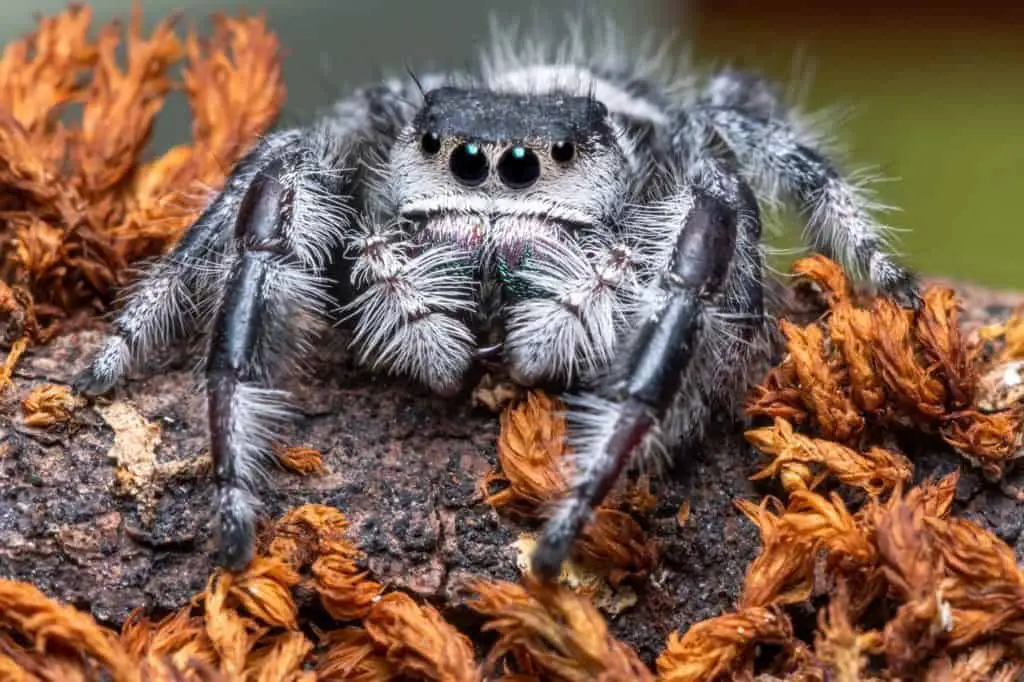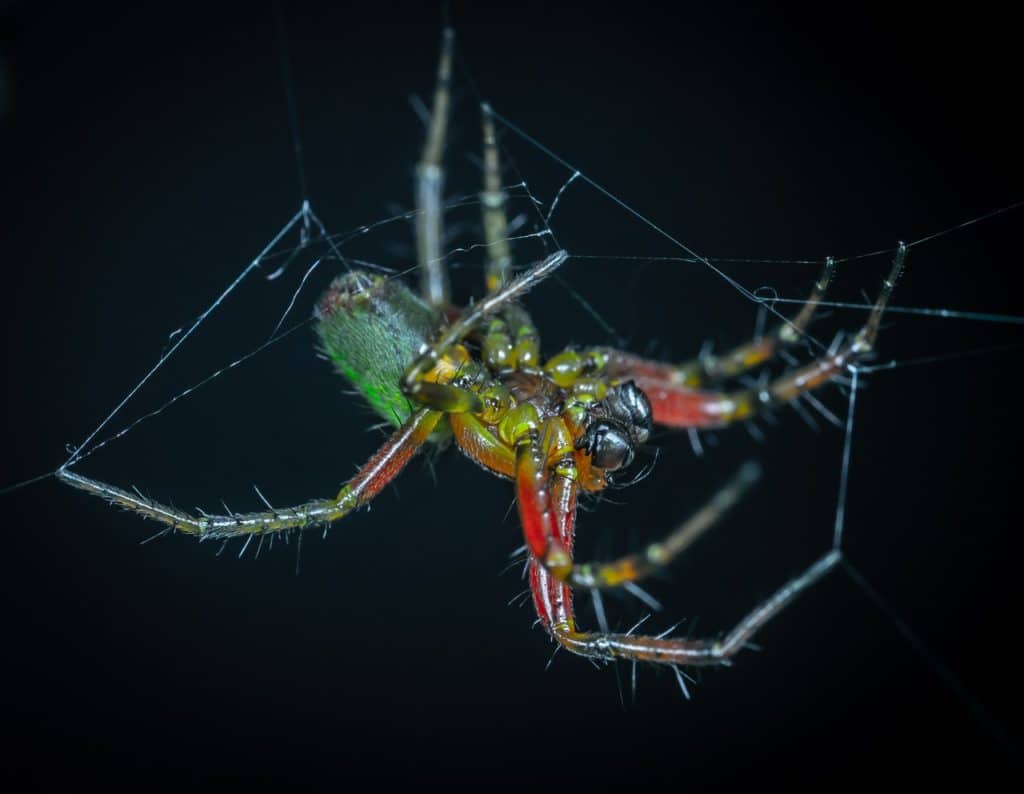
Just like any other animal on this earth, spiders will eventually die. But how do you know if a spider you’re seeing is dying? In this article, I’ll give you an in-depth answer to this question and I’ll also answer a few closely related questions so make sure you keep on reading until the end.
How do you know if a spider is dying? Different signs can give away that a spider is dying. Examples of these signs are:
- The legs of the spider curling towards its body.
- The spider is looking weak and is unable to support its body weight.
- The spider has a shriveled abdomen.
- The spider has stopped drinking or eating.
The signs of a dying spider explained
The legs of the spider curling towards its body
Spiders don’t have muscles to extend their legs outwards and to do this they instead use hydraulic pressure to extend them outwards. Once a spider is close to dying, the hydraulic pressure in the legs of the spider in question will drop and then the legs of the spider will curl up towards its body.
The spider looks weak and is unable to support its body weight
Besides, its legs curling towards the body of the spider, the spider can show even more physical signs that can be linked to its death being nearby. If the spider in question looks, for example, weak when you look at him/her when it’s, for example, unable to support its body weight properly then you can be quite sure that there is something wrong with the spider in question and that it will probably die shortly. A healthy spider should be able to properly support its body weight and have no problem walking around or even running away whenever it feels threatened. Many different things can cause the spider to become weak. Examples are old age, various diseases, or even parasites.
The spider has a shriveled abdomen
A spider that has a shriveled abdomen can also be linked to a spider that might be close to dying. A shriveled abdomen in spiders occurs when the spider in question is dehydrated. Spiders mostly hydrate themselves through their caught prey and that’s also why they’ll also have an undersized abdomen because they were unable to find any prey and therefore haven’t eaten either.
If the spider stops drinking or eating
A spider that’s either not drinking or eating can mean different things. The spider could, for example, not be hungry or thirsty, the spider is about to molt, or it is full of stress and will need some time alone to calm down. Besides these fairly non-harmful reasons, the spider might also have parasites which will also cause him/her to not eat or drink. Unfortunately, parasites in spiders mostly result in the spider dying.
Alternative ways where it might seem the spider is dying but is not
The spider is about to molt
When spiders are close to their molting phase, they’ll stop eating and drinking and they can potentially get a dull coloration. Because the spider loses its appetite before going into a molt, it can sometimes be scary to the owners of the spider as a spider losing its appetite can also sometimes be linked to the spider being close to its death bed.
The spider is in its molting phase
Once the spider goes into its molting phase it will be lying on its back into a spot where he/she feels most comfortable and which has the best humidity levels it could find as good humidity levels are essential for the spider to have a successful molt. Molting can, however, bring the illusion to the owners of the spider that the spider is close to dying because it’s laying on its back. Thankfully, though molting in spiders is very normal and also essential for them to grow.
Check the video below if you want to see a tarantula molt.
The spider is playing dead
Spiders will just like other animals on this earth do everything to survive. If, for example, playing dead is one of the things they could do to survive then you can be sure that they’ll try it. It can even happen that male spiders play dead once they’ve mated with a female spider as the female spider will naturally have them for dinner from time to time. So don’t be mistaken by a spider acting like it’s close to dying or dead because it will bolt once it senses that it is the right time to do so.
You know now what signs to look out for if a spider you’re seeing is dying or not. Do you also want to know in what ways spiders can die? Then I encourage you to check out the article: “In What Ways Can Spiders Die? (All The Possibilities Covered)“.
How to tell if a jumping spider is dying?
Jumping spiders will just like many other spider species show the usual signs which are the legs of the spider curling towards its body, the spider having a shriveled abdomen if the spider stops drinking or eating, or the spider is weak and is therefore unable to support its body weight.
As you can read there are no more additional signs that can be assigned to a jumping spider when it’s close to dying.

How to tell if a huntsman spider is dying?
A huntsman spider will show the following signs: The spider is not drinking or eating anymore, the spider is unable to carry its body weight because it is weak, the spider haves a shriveled abdomen, or the spider haves its legs curled up towards its body.
Just like the jumping spider, the huntsman spider doesn’t show any more signs that can automatically be linked to its dead being nearby.
How to tell if a yellow garden spider is dying?
A yellow garden spider will show the same signs as pretty much all the other spider species out there when it’s close to dying. But there is another sign that will lead to the death of a yellow garden spider. Let’s look at all the signs:
- The spider’s legs curling towards its body.
- The spider is weak and can’t support its body weight.
- The spider has a shriveled abdomen.
- The spider stops drinking or eating.
- The spider has just laid her eggs.
Shortly after the yellow garden spider has laid her eggs, her mission in this world has been fulfilled which is to reproduce, and then she’ll die.
How to tell if a redback spider is dying?
The signs of a redback spider dying are when its legs are curled towards its body, if the spider has a shriveled abdomen, if the spider has stopped drinking or eating, or if the spider cannot support its body weight anymore because it has become weak.
As you can read, the redback spider does not have any additional signs that will give away it’s close to dying like the yellow garden spider but it does show the signs you’d expect to see in spiders.
How to save a dying tarantula?
Saving a dying tarantula might be hard if the tarantula is full of parasites or it might even be that your tarantula is old and is going to die anyway. But it can also be that the tarantula is dehydrated and that’s when you can indeed save its life. Check out this article to find out how.
In general, though, saving a dying tarantula is going to be hard. What you can, however, do when you’re pretty sure that the tarantula in question is going to die, is make sure that the tarantula is comfortable by providing it the right humidity level, temperature, and a spot where it will feel safe.
Related questions
Will a tarantula die from a fall?
Tarantulas can very easily die from a fall. Although, them dying from a fall doesn’t always have to be the case. Tarantulas are a very fragile spider species that can die of a broken leg from a fall, of becoming wounded from a fall, or it can die if the tarantula happens to break its exoskeleton.
Can spiders die of fright?
There is evidence to be found online that spiders can die of fright (check it out here) but it’s also the only evidence I was able to find. It’s unlikely that they will die of fright, however, it can happen that they’ll indirectly die of fright as they become stressed and therefore stop eating.
Why do spiders flip over when they die?
It isn’t always the case that the spider will flip over once it has died, for example, when it dies whilst standing. When they, however, die and fall out of their web then it is likely that they’ll land flipped over as their body weight will be higher than the weight of their legs.

Conclusion
Now you can tell when a spider you’re seeing is potentially coming to the end of its life. I’m saying potentially here because you can’t always be entirely sure about it. There are, for example, also situations possible where the spider in question is just playing dead which can also result in the legs of the spider intentionally curling towards its body. Or it might even be that the spider in question isn’t drinking or eating because it is going to molt. So to be 100% sure is hard but the covered signs in this article will often point in the direction of a dying spider.

